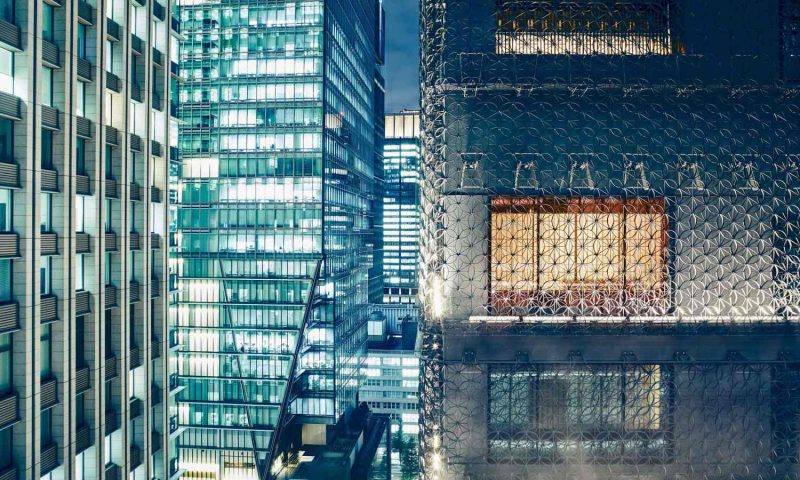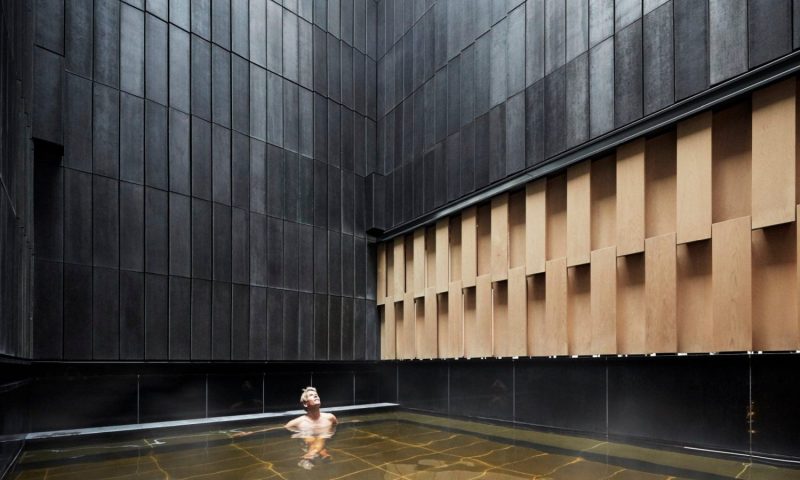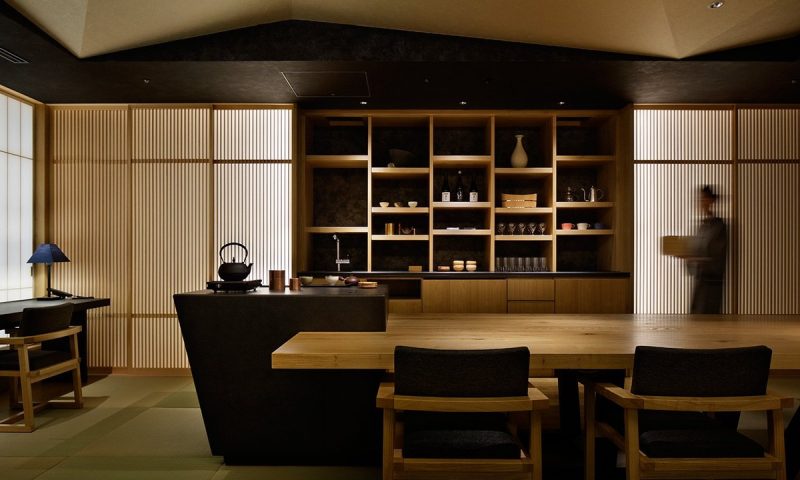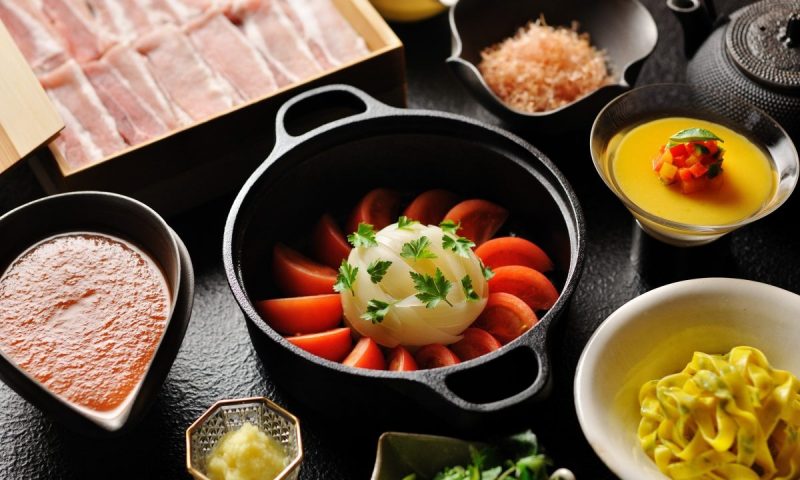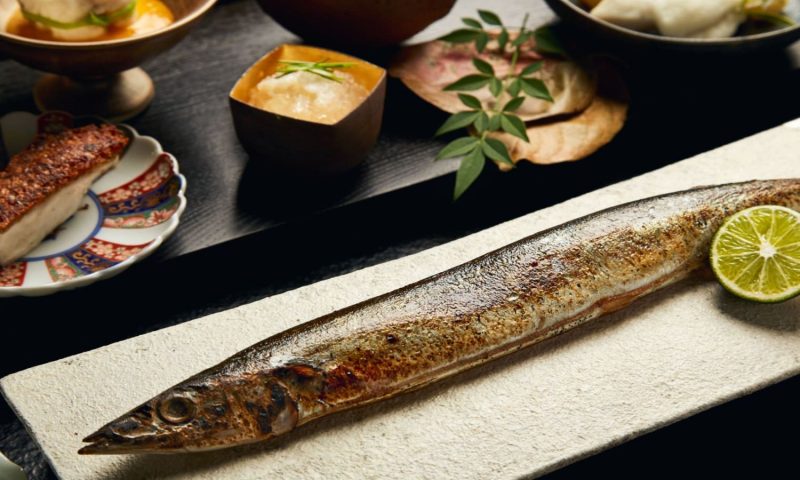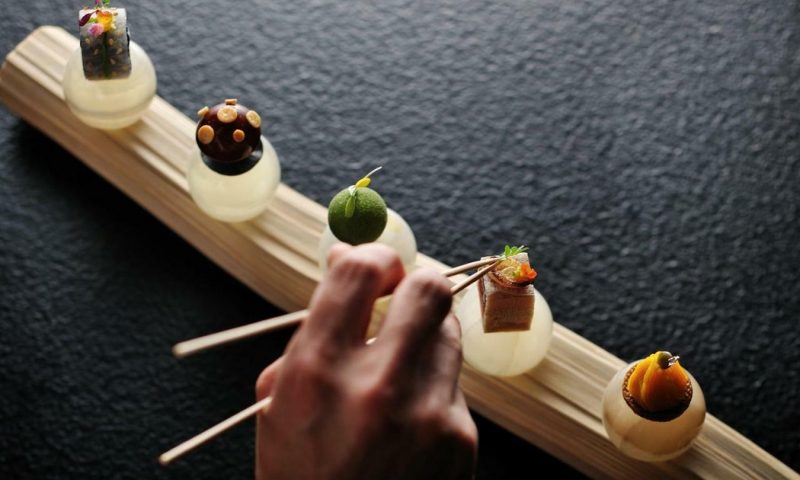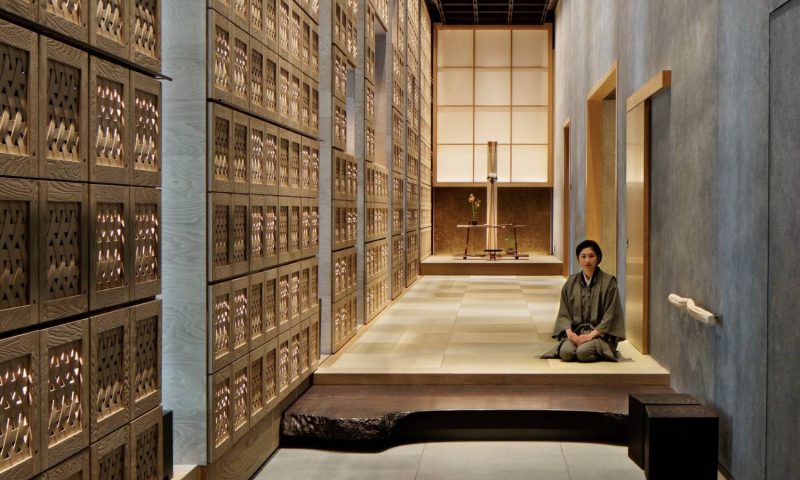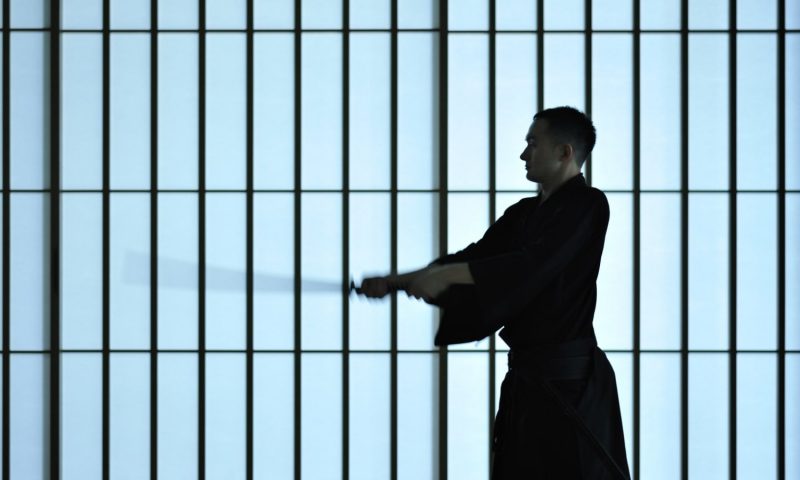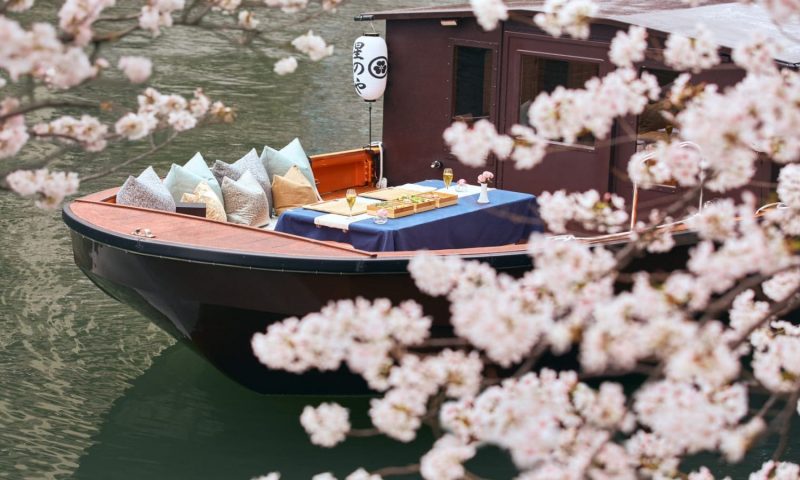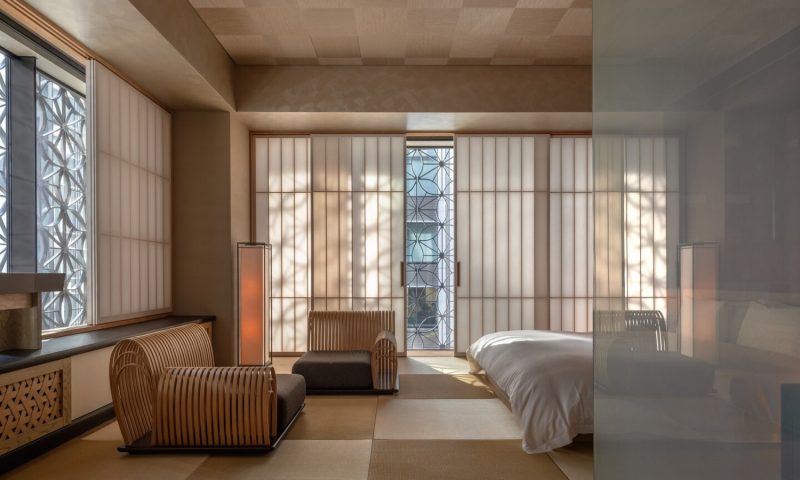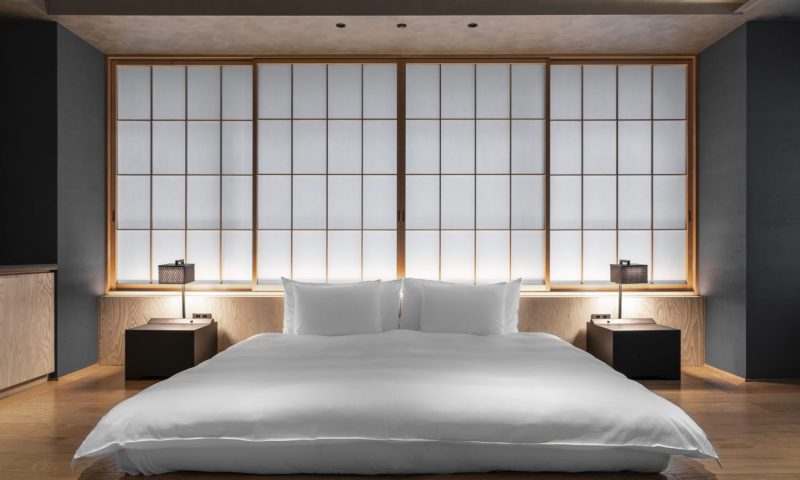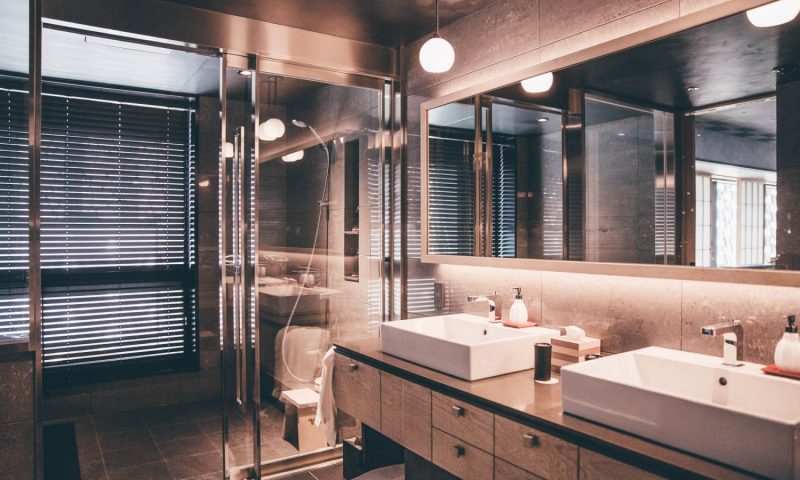HOSHINOYA Tokyo lies in the city’s economic center, a short walk from Tokyo Station and the Imperial Palace. In contrast with its grand facade, the 17-story hotel offers a relaxed ambience with a sense of intimacy and surprise–qualities that are rooted in traditional Japanese hospitality.
Each floor is an exclusive domain, accessible only by the guests staying there, and with a dedicated staff in place to meet their every need, as well as to maintain the elegant customs that have been honored for centuries at the traditional Japanese inn–the ryokan.
Initially, the ryokan appears as a tall black monolith that blends in with its surroundings, a landscape of towering office buildings that compose Tokyo’s financial heart. As you get closer, you see that its dark exterior is actually an elegant lattice of leaf-like patterns, or komon, that veils the ryokan.
Outside the entrance are multihued stone benches shaped like boats and planters that resemble ikebana vases, forming a contemporary Zen garden. You soon realize there is nothing monolithic about this ryokan.
The enormous entryway door–made from a single cut of cypress–quietly opens. A guide in a kimono greets you with a smile, closing the door behind you as you step inside. Suddenly, all noise has come to a standstill.
A long tatami hallway extends before you, ending at an alcove that displays a seasonal ikebana arrangement. An impressive array of bamboo shoeboxes lines the hallway. You take off your shoes and walk down the hallway in your socks.
It is what you had imagined a traditional ryokan would be, and yet completely different. You quietly marvel at this seamless marriage of the traditional and the contemporary.
THE HEART OF A JAPANESE RYOKAN
To the sound of wooden clappers, you arrive at your floor–a ryokan within the ryokan composed of guestrooms and a lounge called an ochanoma. Seasonal sake and confectionery are set out in the lounge for guests on the same floor to enjoy at any time. You imagine you will be spending a lot of time here, and that you may often encounter the other guests. Perhaps, you might make some new friends.
The books in the lounge change throughout the day, as if an invisible proprietor were letting his presence and character be felt. You begin to understand the importance of the ochanoma in ryokan culture. It is more than just a common living space for guests; it is the beating heart of the establishment.
STIMULATING DETAILS
As you put on the kimono that has been laid out for you in your room, you notice how quiet it is. It is an elegant silence that permeates the ryokan, accentuating the details–such as the aesthetic shadows that form on the tatami floor as sunlight passes through the komon-patterned lattice veiling the building, the scent of bamboo released when opening the closet, and the intricate tatami grains. Every element stimulates the senses, emboldening you to venture into town while dressed in your kimono.
A PRIVATE DOMAIN
HOSHINOYA Tokyo is structured like a tower where every floor functions as a 6-room ryokan, an exclusive domain accessible only to guests staying on that floor. Most activity takes place in the ochanoma–a lounge that is seamlessly connected to every room on the floor via a tatami-matted corridor.
Like in ochanoma at classic ryokans, a wide selection of refreshments–seasonal teas and confectionery during the day–are set out for guests staying on that floor to enjoy at any time.
Guests are encouraged to treat the ochanoma as their own living room, where they may read a book, do some work, or relax and pass the time. Rooms combine traditional design with contemporary furnishings, but the lighting is classically Japanese.
Windows hidden behind shoji screens can be opened during the day to let the light project elegant shadows on the tatami floors; lights concealed behind walls and in paper-like casings produce soft illumination. Baths are wide and deep so that guests may fully soak themselves in the water.
KIKU ROOM
Soft sunlight pours in through the paper window screens in these south-facing corner rooms, which are about twice as large as the Yuri and Sakura rooms. Furnishings include a dining table, a small desk, and a sofa that is wide enough to lie on.
The bathroom features a satisfyingly deep bathtub and a shower stall, with windows that can be opened to bring in cool winds. Up to three Japanese futons can be laid out on the bed stand.
THE RYOKAN CONCEPT
Azuma, who has designed all four HOSHINOYA resorts to date, designed the interior and acted as consultant for the exterior, which was built by large-scale construction specialists Mitsubishi Jisho Sekkei and NTT Facilities.
Building a ryokan right in the middle of Tokyo was always going to be an ambitious project, but it was important that such scale did not overwhelm the HOSHINOYA ethos. Azuma, therefore, started with the most basic concepts associated with ryokan.
Upon arrival at a traditional ryokan, a guest first removes their shoes, and is then led to their room. Although simple in nature, this process is significant.
It is both an invitation for the guest to treat the entire building as if it were their home, as well as a confirmation of the inn’s exclusivity—one cannot enter the premises uninvited. Believing this to be a valuable cultural experience, Azuma used this as a basis for her entire interior design concept.
She started by making sure every walkable surface, including corridors, was layered with soft tatami matting; unlike the typical ryokan, there are no wooden floors. She then outfitted the rooms and public areas with furnishings that encourage a floor-level style of relaxation as is traditional in Japan.
The exterior of the structure is shrouded by a metal lattice of komon patterns. These patterns are traditionally featured on kimonos and are designed to be difficult to discern from a distance, while revealing their elegance up close.
By veiling the building behind this classic design, Azuma has given it the look of an elegant jewel box hidden among the soaring office buildings that surround it. HOSHINOYA Tokyo promises a new kind of ryokan experience for both Japanese and non-Japanese guests.
ADDING COLOR TO THE URBAN LANDSCAPE
Hasegawa designed the resort’s landscaping in collaboration with Mitsubishi Jisho Sekkei. Unlike the sprawling, secluded premises of other HOSHINOYA resorts, HOSHINOYA Tokyo is a singular building that shares a public urban landscape with other high-rises.
Hasegawa sought to ensure that the area immediately around the building clearly announced itself as an extension of the premises, while also contributing something new to the local landscape.
HOSHINOYA resorts have always served as conduits to the unique features that can be found in their locations; in this case, Hasegawa latched onto the city’s ability to conjure the feeling of a great amount of space on even the tiniest of plots.
To that end, Hasegawa built an inviting garden-like space that contrasts greatly with the buildings that tower all around. Four bands of patterns weave through the space, flowing around a collection of tiny objects.
There are small, intricately sculpted trees, benches shaped like boats, and planters designed to look like decorative vases. Each item is a work of art painstakingly created by artisans such as Kyoto’s Ueyakato Landscape Co. and wood and ceramic furniture makers Apex.
These objets d’art reflect the artisanal essence of traditional ryokan and offer a preview of the purely Japanese experience that awaits inside.
REPLICATING THE WARM LIGHTING OF A RYOKAN
Takeishi created the resort’s lighting design in collaboration with Mitsubishi Jisho Sekkei. Although Takeishi ensured that certain aspects of the lighting were commanding enough for the resort to stand up to the contemporary high-rises all around, his main focus was on replicating the warmth associated with ryokan.
In other words—light that is inviting, light that breathes, light that lingers, and light with a sense of interplay. For the exterior, he used upper lights to create gradation over the lattice of patterns veiling the building so that it would stand out.
In the entrance, guests are welcomed by washi paper pendants that echo traditional Japanese paper lanterns, as well as walls with lights imbedded in a checkered pattern. In the private spaces, Takeishi designed a more subdued lighting scheme. The tatami corridors just outside the guestrooms are lit from behind shoji sliding doors.
Rooms, themselves, are gently lit via indirect lighting from the ceiling, as well as floor-level light stands (based on andon paper lamps) with arrow feather motifs.
The communal baths, which are unusual in that they have open roofs, feature indirect lighting from the walls. This creates a relaxing ambience while enhancing the natural light from above, simulating the experience of bathing in an outdoor hot spring.
The aim of this lighting scheme is to encourage guests to stay at the resort, get comfortable, and spend long, relaxing hours inside without feeling the need to leave.
DINING
Every season, Japan’s forests produce a rich variety of minerals that sustain the ingredients I use in my cooking. My goal at HOSHINOYA Tokyo is to show the world how wonderful these ingredients are.
Through my Nippon Cuisine, I want guests to enjoy these minerals produced by Japan’s forests. Japan is surrounded by seas that are visited by warm and cold currents–ideal conditions for raising high-quality fish.
Over 70 percent of Japan is hilly or mountainous and full of nutrient-rich soil. Rainwater carries these nutrients to the sea, allowing for an even higher quality of fish. The minerals of Japan’s forests have nurtured rich culinary cultures across the country; some vegetable and fish delicacies can only be found in certain parts of Japan.
As head chef of the only genuine ryokan in Tokyo, I feel it is my duty to treat my guests to these hidden delights–to give them a taste of not just the best of Tokyo, but the best of Japan.
We often talk of ingredients being “in season.” What most people don’t know is that this season lasts for just two or three days. This is why I procure my ingredients only from trusted farmers and fishermen who always send me ingredients when they are at their best.
Sometimes, I receive quality fish that can only be found in one specific part of Japan. Every morning, these select ingredients arrive at our doorstep. I study each ingredient, waiting for it to speak to me so I can transform it into a wonderful dish, made with skill and inspiration.
Every day, I discover something new about the minerals produced by Japan’s forests–they really are one of Japan’s greatest treasures. In a way, the hills and the seas do half my job for me.
My hope is that Nippon Cuisine finds a worldwide audience so that even the lesser-known culinary delights of Japan can enjoy the spotlight, along with the wonderful farmers and fishermen who deliver them to my kitchen.
NIPPON CUISINE
Guests are served Nippon Cuisine, a culinary style that focuses on fish–a common staple of ryokan dining and a key element in Japanese culinary culture. Every ingredient is flavored with carefully selected seasonings and prepared by our executive chef, using his award-winning French techniques.
THE EXECUTIVE CHEF – NORIYUKI HAMADA
After becoming the youngest winner of the Bocuse d’Or Japan gastronomic competition in 2004, Hamada went on to win Bronze at the 2013 Bocuse d’Or World Finale–where he also earned 1st place in the fish category.
Since then, he has made it his life mission to propagate a new style of French cuisine that incorporates Japanese craftsmanship, culinary technique, and ingredients. At HOSHINOYA Tokyo, he uses Japanese ingredients and dishware to produce a creative interpretation of ryokan dining.
CELEBRATING IN STYLE AT A RYOKAN
The ryokan is a place where people visit to get away from their busy lives so they can enjoy some quiet serenity and the sensory delights of the season. It is the perfect place to organize a celebration, especially when it includes a dinner prepared by a world-renowned chef. With a dedicated staff ready to meet your needs, we promise a memorable experience for host and guests alike.
HOT SPRING BATHS
You sink yourself into an indoor hot spring bath fed from 1,500 meters below Tokyo. The thick, saline waters have an energizing effect; you feel a deep vitality coursing through your body. A tunnel leads away from the bath; you wade through it and emerge into the outdoor bath.
A gentle night breeze blows in through the open roof, a privilege afforded by the bath’s location on the top floor. You gaze up at the sky. It is a serene expanse of black, almost unblemished by the glare of city lights. For a moment, you forget you are in the center of one of the busiest metropolises in the world.
From the minute you stepped into the ryokan, you have been immersed in a world unlike any you have visited. It is a world where one is constantly enveloped in the aroma of sandalwood woven into the tatami, and where one is reminded of the beauty of the seasons through spectacular flower arrangements.
Gentle lighting, soft kimonos, and plush bedding induce relaxation, while conversations in the ochanoma and meals designed around lesser-known delicacies of Japanese cuisine provide pleasant stimulation. You hope to return during a different season so you can experience all this again, as if for the first time.
The top floor of HOSHINOYA Tokyo consists of two bath halls, separated by gender. The baths are fed by hot spring waters drawn from 1,500 meters below the ground. Due to its high saline content, the bath water is pleasant to the skin, gently relaxing the body while improving its ability to preserve heat.
Each bath hall contains an indoor and outdoor bath, connected by a cave-like tunnel. The outdoor bath is located at the bottom of an open-roof chamber with soaring walls that frame the sky above.
Through the open roof, guests are presented with a private viewing of a dynamic tapestry painted with the ever-changing colors of the sky and decorated with clouds of many shapes. At night, pleasantly cool breezes blow in, bringing seasonal aromas with them.
SPA & WELLNESS
The spa at HOSHINOYA Tokyo offers therapies designed to guide the body towards its optimal state. Therapies begin with a soak in the baths and some stretching exercises to loosen the body.
Guests are then led through a program focused on health and beauty and an oil treatment session, each one tailored to the guest’s goals. At the end of the therapy, guests will feel refreshed in both mind and body, and ready to embark on a healthier and more exuberant lifestyle.
EDO BEAUTY STAY
This program is designed to allow guests to turn their attention to beauty of old Edo-Tokyo, through a variety of activities such as learning graceful hand movements, exercises, as well as a relaxing spa treatment.
A PRIVATE FAMILY STAY
This special stay is offered for the whole family to savor a once-in-a-lifetime private getaway together to celebrate a special event. Not only will you have a whole floor to yourselves, your celebration will also be made extraordinary with traditional instrumentals and delicate meals.
SUMO TRAINING VIEWING & A TRADITIONAL HOTPOT MEAL
Sumo is the oldest national sport in Japan. Its roots date back to ancient times during the nation’s history and became widely popular during the Edo Period. Enjoy viewing the sumo wrestlers’ morning training session. After the viewing, you will have a rare chance to sit alongside them and try their traditional hotpot dish, “Chanko Nabe”.
JAPANESE TEA CEREMONY
The Japanese tea ceremony is not simply about offering tea to guests. It is about providing an opportunity for fully appreciating the current season–whether through the colors of the kimono one wears, the motifs of the confectionery served with the tea, or the aromas produced by the tea that one pours.
The activity offers guests an opportunity to gain a deeper appreciation of Japanese hospitality. The featured tea bowls and whisks have been created exclusively for HOSHINOYA Tokyo by an artist; guests are allowed to keep them.
GAGAKU PERFORMANCE
Gagaku is a traditional Japanese theater art that mixes dance with music. Under the supervision of Fumihiko Yamada, an expert on traditional Japanese theater arts, gagaku performers dance elegantly to mystical sounds produced by ancient instruments on a stage set up in the lobby. Guests are invited to watch the show while enjoying a drink.
THE ART OF INCENSE
Guests are invited to try kodo, the art of appreciating incense. Three types of wood are lit inside a modern burner; guests are then asked to describe the differences in their scents. Through this ancient parlor game, guests may develop a keener sense of smell.
MIDTOWN HELICOPTER CRUISE
Guests are given an aerial tour in a helicopter above one of the world’s largest metropolises. The views of Tokyo from 600 meters in the air are spectacular, and well worth sharing with loved ones.
RICKSHA TOUR
Guests are picked up at the entrance of HOSHINOYA Tokyo by a ricksha driver, who will take them on one of three tours handpicked by the resort staff. Rickshas are designed to shelter riders from rain and snow, allowing guests to enjoy this experience in any weather. Ricksha drivers are well versed in the city’s history and will happily share their knowledge.
TOKYO RIVER CRUISE
This leisurely cruise along Tokyo’s historic waterways offers spectacular views of Tokyo’s cityscapes, as well as a visual history of river transportation in the city. Privately rental boat will be a perfect way to celebrate a special occasion or to simply enjoy a private nighttime trip through Tokyo. Guests who wish to procure tickets for regular boat tours may inquire at reception.
